info@motofeed.com
Harley-Davidson Low Rider S vs. Indian Sport Chief
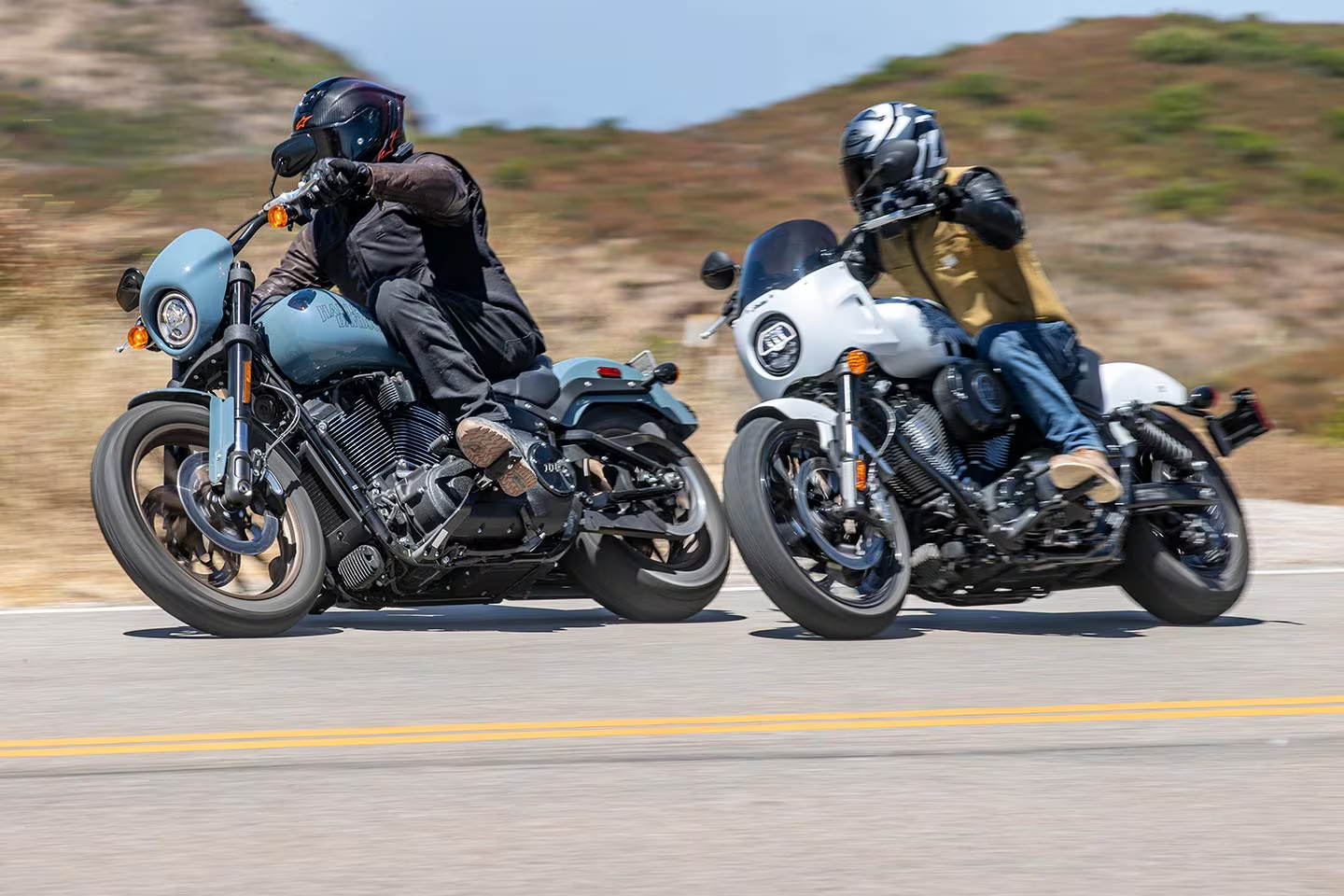
Has Indian built a better performance cruiser than Harley-Davidson?
By Bradley Adams | www.cycleworld.com
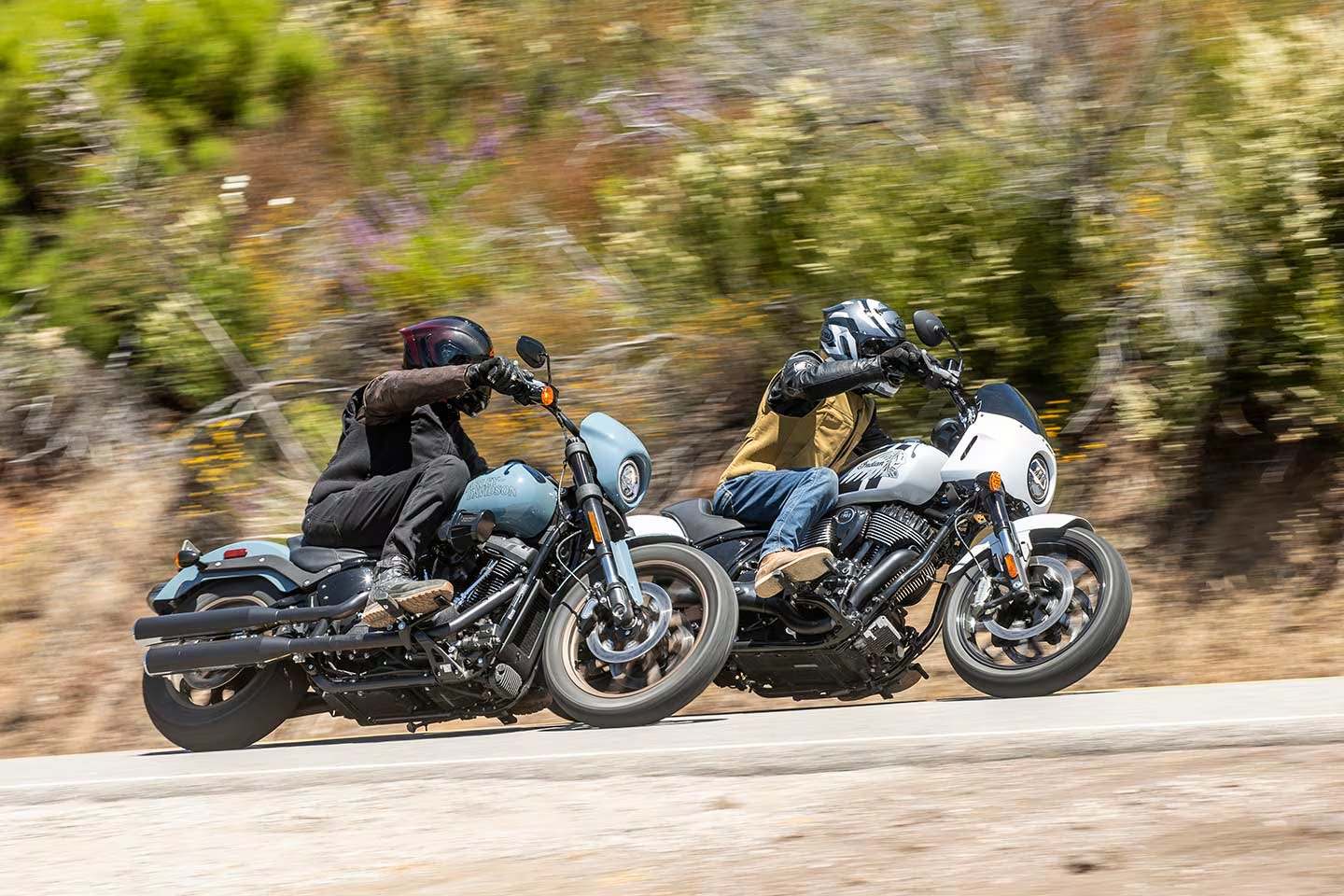
If you wondered where the inspiration for the modern performance cruiser came from, take a look in the mirror. OK, maybe the inspiration didn’t come from you specifically, but bikes like the Harley-Davidson Low Rider S and Indian Sport Chief weren’t born by chance. They exist because an overwhelming majority of riders proved there was a market for tall, West Coast–style performance cruisers. And because there’s nothing more American than stuffing a big V-twin in a cruiser chassis with sporty suspension. Style with a heap of performance on top? Yes, please.
Harley-Davidson was the first to capitalize on the custom, West Coast trend, primarily because its legion of loyal fans had built the trend on The Motor Company’s bikes, specifically on the FX (Factory Experimental) with roots going back to the 1971 Super Glide.
Leading up to 2016, H-D design knew the twin-shock Dyna’s days were numbered and launched the Low Rider S. But even if that bike captured what customers had been doing with dual-shock, rubber-mount Big Twins for decades, Harley-Davidson was consolidating its heavy cruiser line into one platform and Dynas exited stage left in 2017. The overhauled Softail lineup followed in 2018, and many tears were shed over tall black socks and Vans Old Skool shoes by the faithful. Fortunately, the Low Rider S was reintroduced as a Softail and with a Milwaukee-Eight 114 engine in 2020, before being outfitted with a Milwaukee-Eight 117 in 2022.
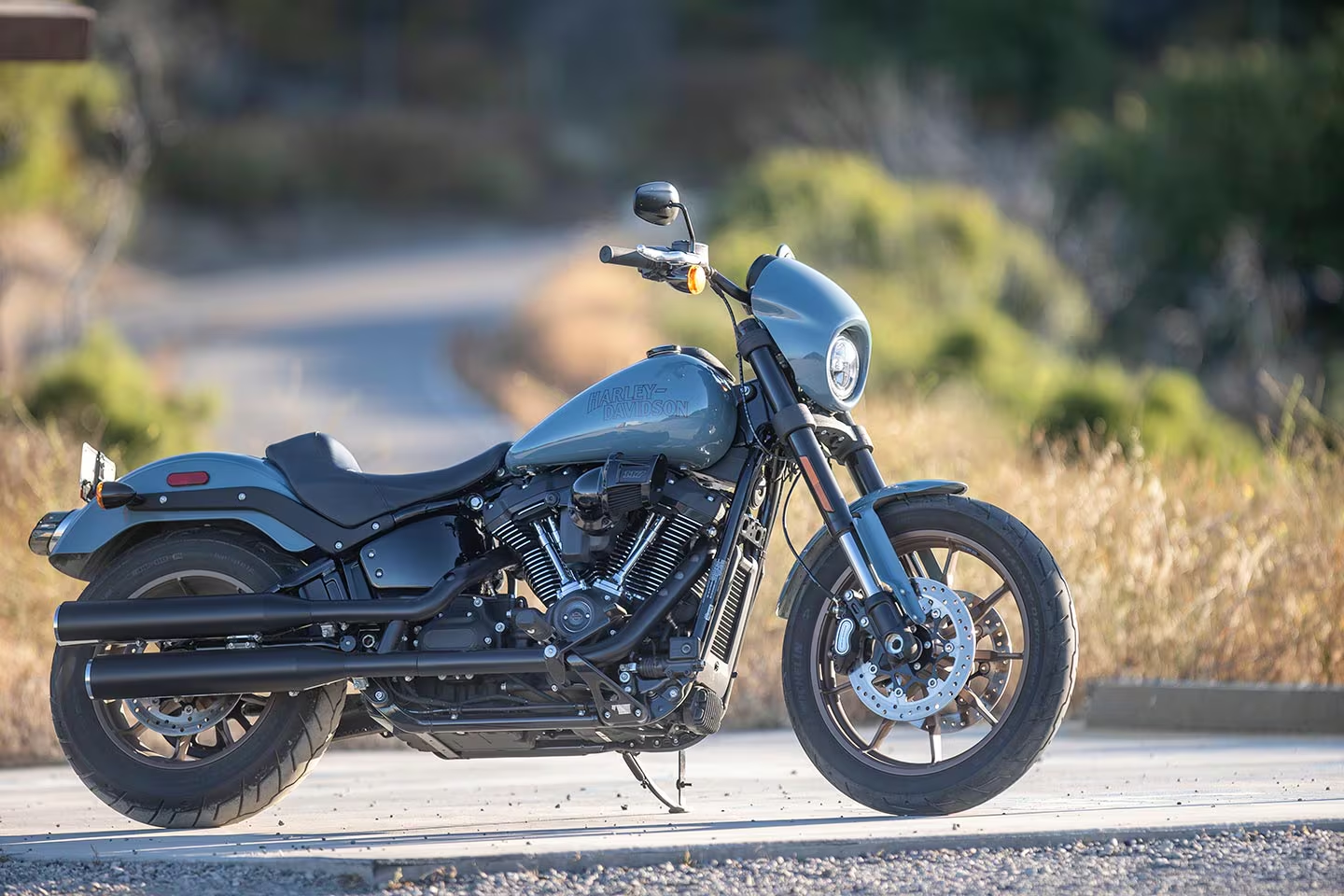
The Sport Chief’s history isn’t nearly as convoluted. After letting its Chief platform sit relatively unchanged since 2014, Indian fundamentally overhauled its cruiser lineup in 2022 with more stripped-down, visually lighter bikes like the Chief, Chief Bobber, and Super Chief. Number of non-bagger models with swoopy Indian-traditional full fenders? Precisely zero. The new Chief cruisers are great bikes that markedly improved performance and finally offered more easily customized steel frames (in place of aluminum). The only thing missing from the line was a performance cruiser with West Coast style, and just a year later Indian filled that void with the Sport Chief.
With two legitimate, American-made performance cruisers now available, the question is, who builds a better West Coast–style performance motorcycle? The answer, we assumed, lies somewhere on the California coast and in the mountains that spawned this cruiser subculture. Turns out, that answer isn’t as easy to find as you might expect.
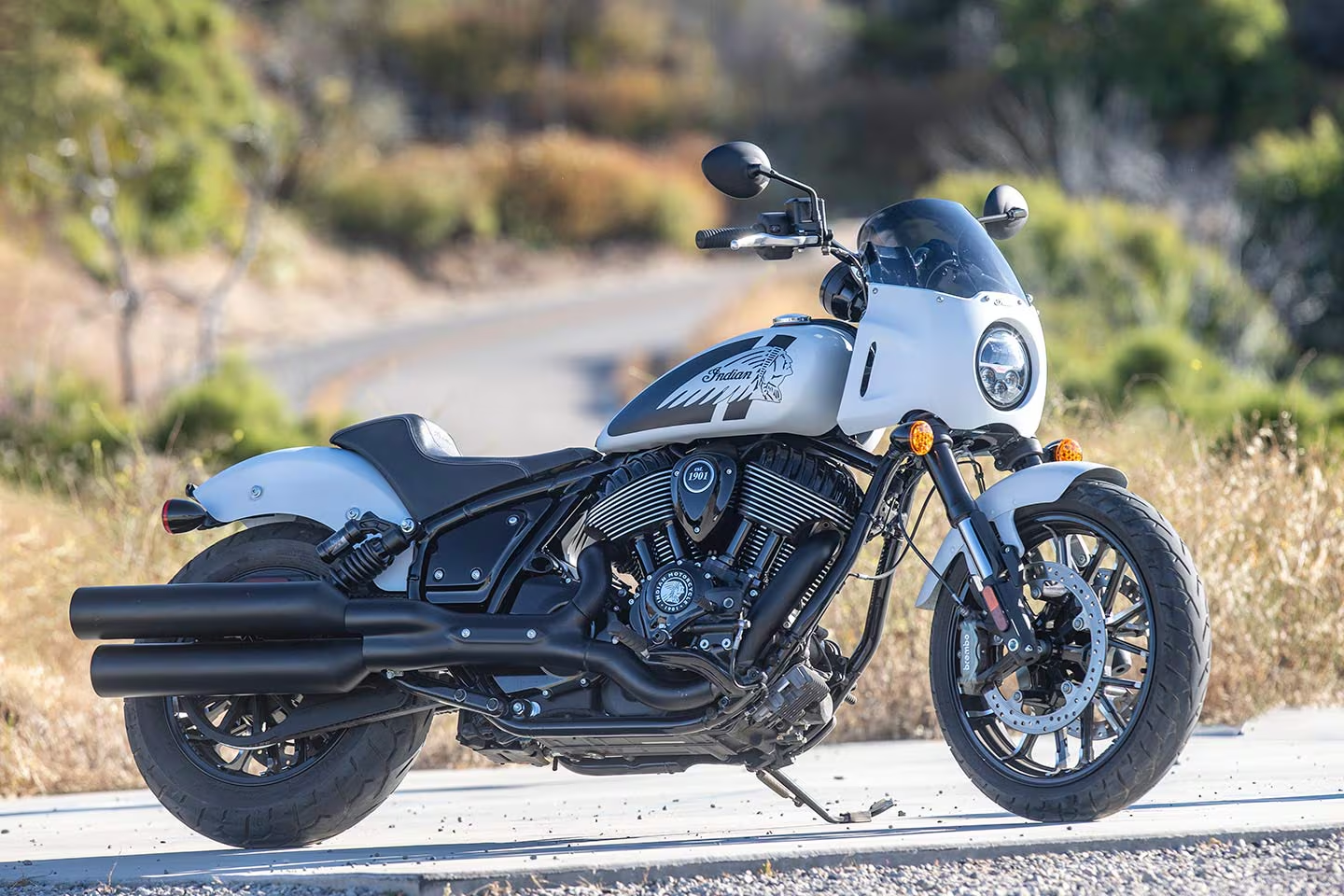
A Closer Look at the Bikes
Scour the internet for a definition of West Coast club styling and you’ll come up surprisingly empty-handed. That doesn’t mean there’s not an unwritten blueprint behind “tall-bike” West Coast builds, most of which include some combination of aggressive ergonomics, a small front fairing, tall-back seat, and performance upgrades for engine, chassis, and brakes. There isn’t a formula, but there’s definitely a formula…
That’s only important to know because it explains the similarities between the bikes splayed across your screen. The Low Rider S, for example, expands on Harley’s Softail Standard platform through the addition of that Milwaukee-Eight 117 engine (versus a Milwaukee-Eight 107), a sportier inverted fork with triple-rate springs (versus conventional fork with dual-rate springs), more aggressive geometry, and a taller, more performance-oriented shock. Cornering clearance increases 2.8 degrees.
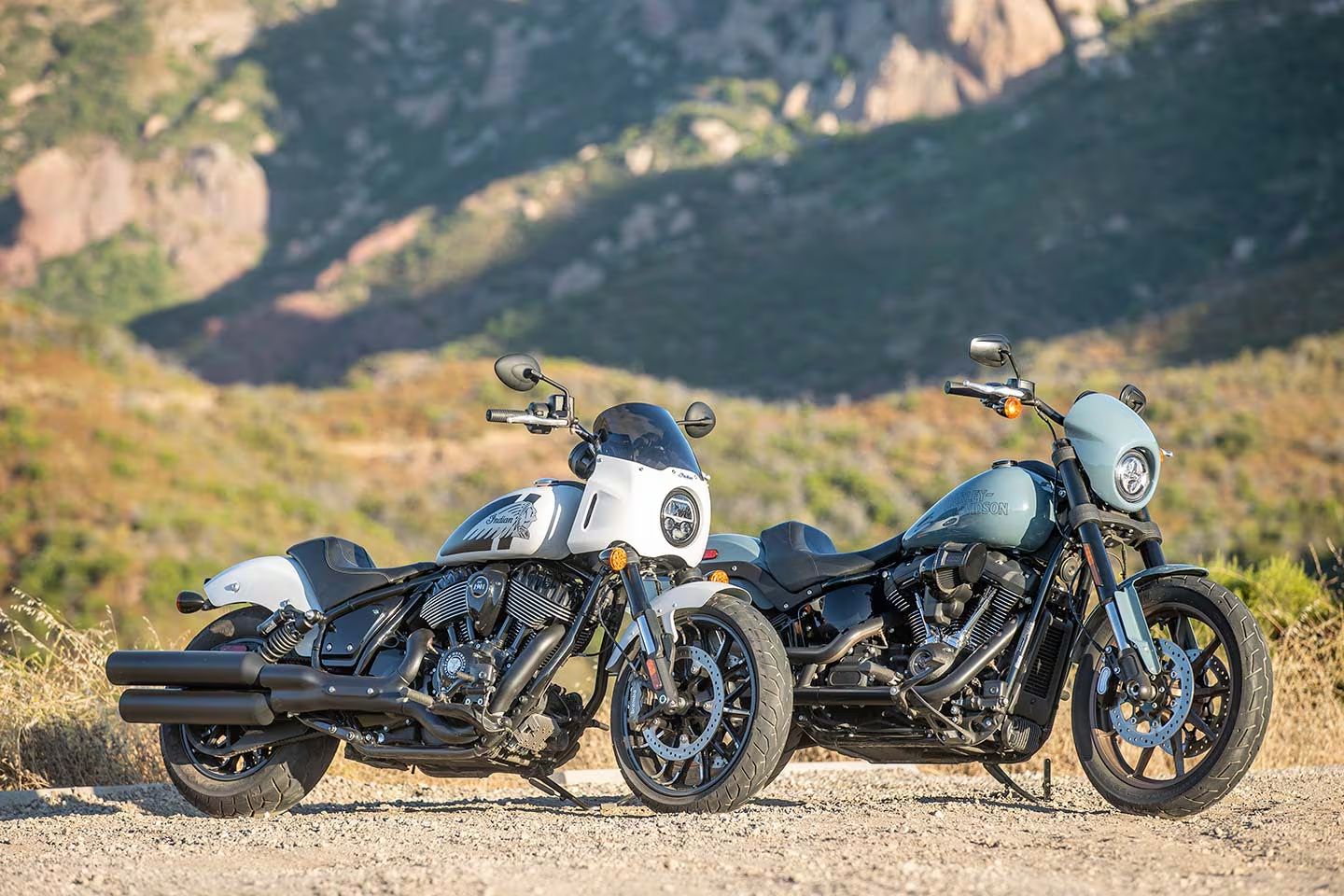
West Coast styling here means you get 4-inch bar risers paired to a moto-style handlebar, Speed Screen fairing, high-back solo seat, and virtually no chrome. The jury is still out on the all-black wrinkle paint that hard parts are doused in (only because our own staffers argue about liking it or not), but we’re fans of the bar-mount display that replaced the tank-mounted cluster on previous-gen models. The heavy-breather intake and color treatments on the Low Rider S are nice touches too—subtle reminders that this scene is just as much about style as it is performance.
If you are not a fan of the Low Rider S for any reason, then turn your attention back to the Indian, which has a slightly more luxurious and less industrial appearance. Black is still very much the color of choice, but gloss paint and machined finishes on the bar risers and top triple clamp give the Sport Chief a higher-quality look from the saddle. Same goes for the full-featured, 4-inch touchscreen display that feels like the right display to have on a $20,000 bike.
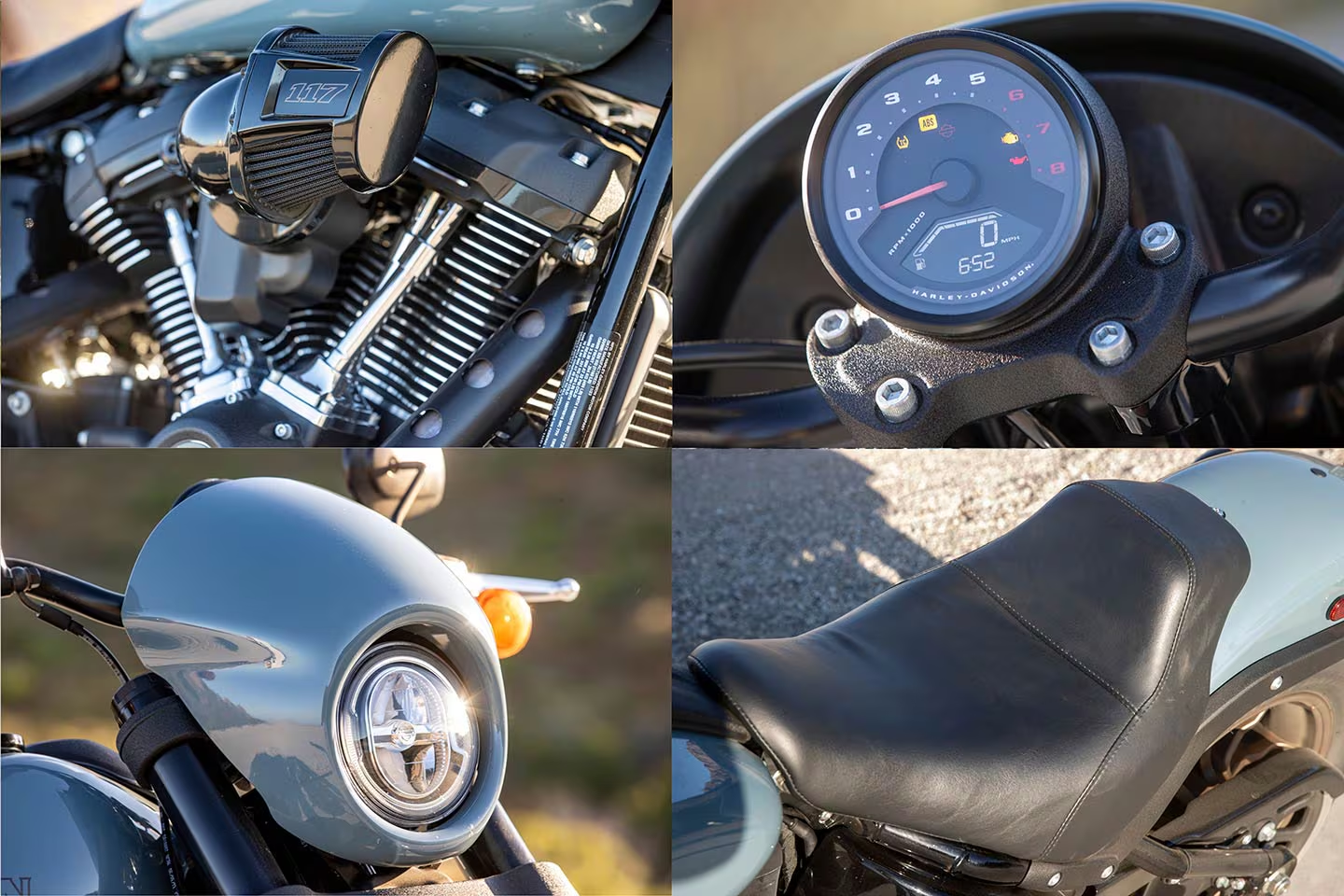
Supplementary hardware matches what you’d expect to find on a West Coast–style build: Six-inch bar risers are mated to a moto-style handlebar. There’s a quarter fairing with small-but-effective 6.5-inch windscreen, plus KYB inverted fork, upgraded Brembo calipers, and larger, 320mm brake discs. Compare that to the conventional fork and single, 300mm brake disc setup on the base-model Chief.
The story is the same out back, where you’ll find a more supportive and stylish solo seat and Fox piggyback shocks. Power upgrades come in the form of Indian’s air-cooled Thunderstroke 116 engine, which offers more performance than the Chief’s Thunderstroke 111 and is very much the main attraction when you walk up to this bike. Remember what we said about Americans loving big V-twin engines stuffed in sporty chassis? Well this is a big engine—both in displacement and physical size.
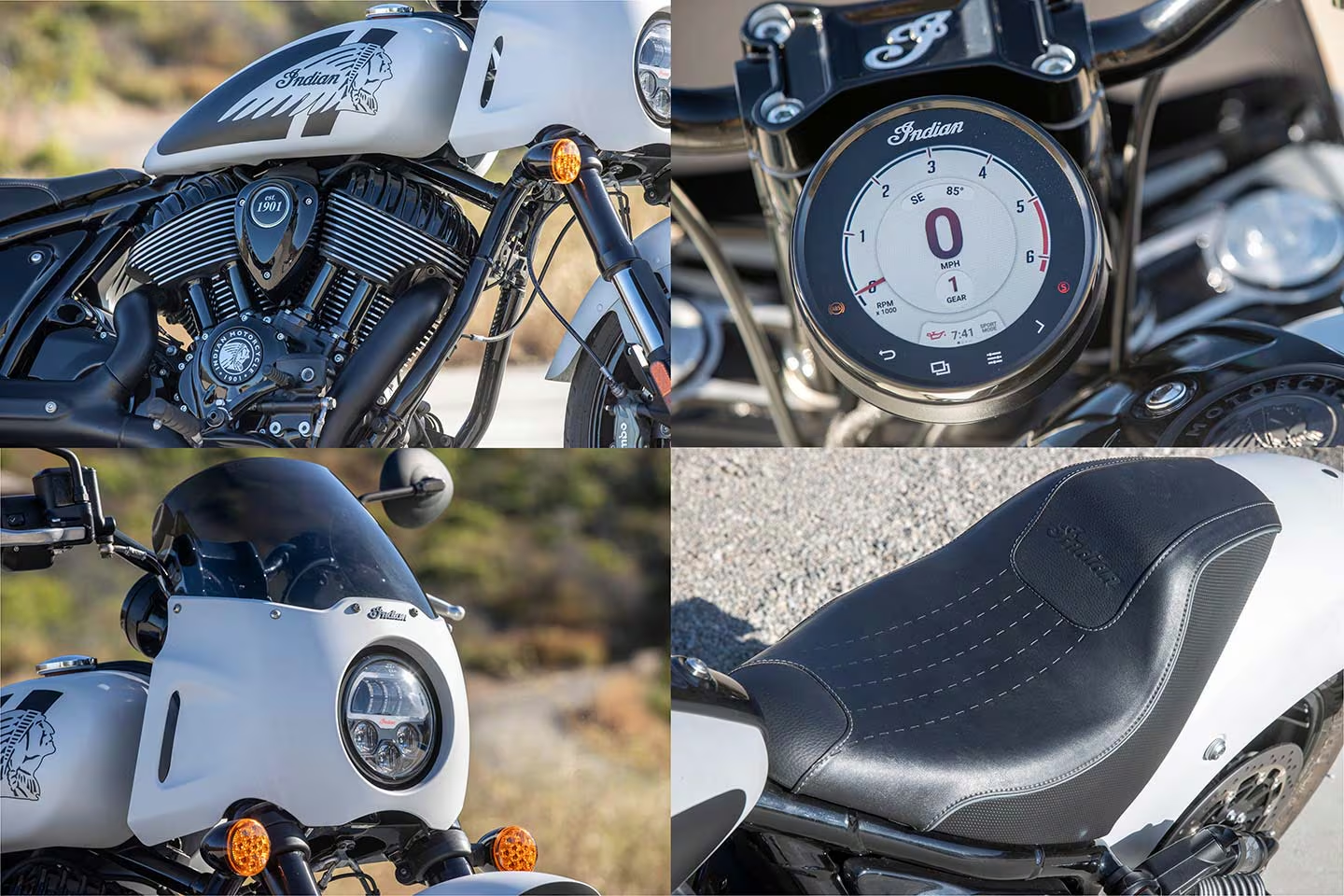
Even though it doesn’t present as “largely,” Harley-Davidson’s four-valve-per-cylinder oil/air-cooled Milwaukee-Eight still has an obvious performance advantage versus the two-valve-per-cylinder Indian. When strapped to our in-house dyno, the Low Rider S made 92.98 hp and 114.82 lb.–ft. of torque, whereas the Sport Chief could only manage 73.70 horsepower and 105.17 lb.-ft. of torque. This and a smoother power delivery also gave it the advantage in quarter-mile testing.
We have to give the sound award to the Sport Chief though, thanks to its deeper and more full exhaust note. We’ve talked often about H-D’s in-house sound chamber on these pages, and recognize how important that “cruiser sound” is to The Motor Company, so to have the Sport Chief be the better sounding bike is a nod to the lengths Indian has gone to not be “the other cruiser option.” Another nod goes to the Sport Chief’s electronics package, which includes three ride modes (Sport, Standard, Tour) and a rear cylinder deactivation system that keeps the air-cooled twin from blessing you with unwanted reminders of how hot your ride is. Both bikes come with cruise control, a USB port, and keyless ignition, though the Low Rider S also gets traction control—a curious omission on the Sport Chief.
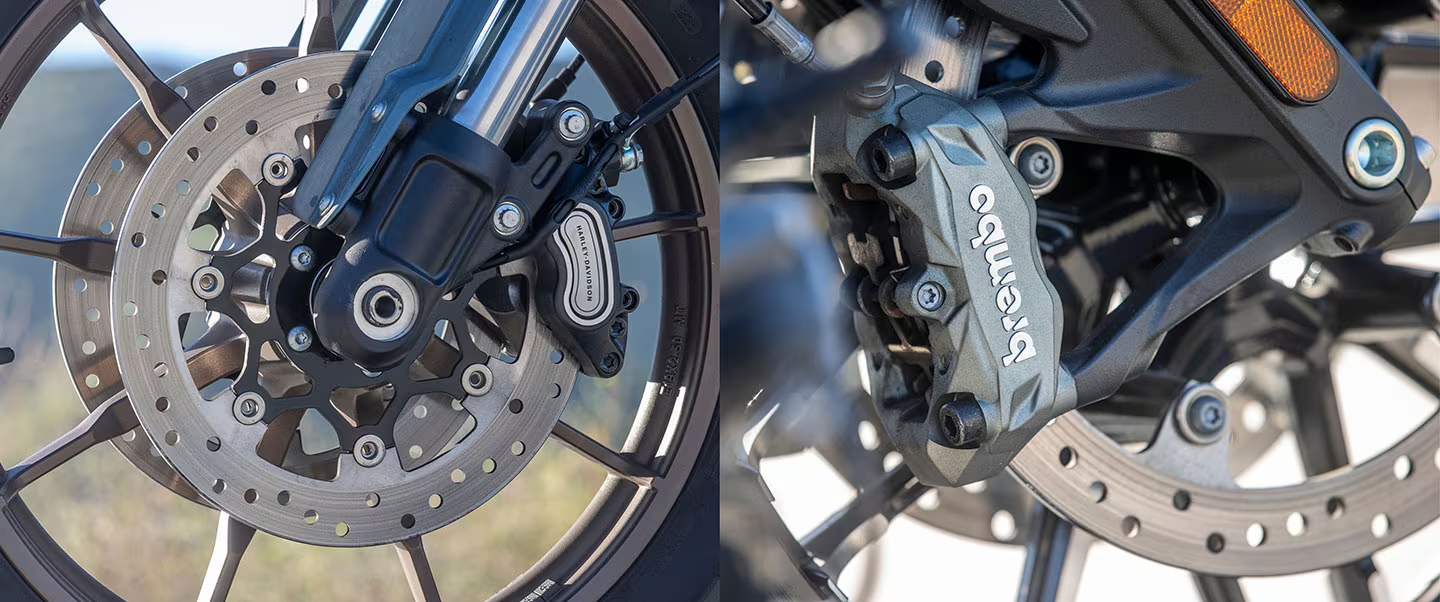
When Rubber Hits the Road
If when reading about the Sport Chief’s touchscreen display and ride modes you were thinking, “I don’t need any of that on a cruiser,” well, you might be right. Or at least in this case you might be absolutely right, because while the TFT display and modern touches look good on paper, the Sport Chief’s electronics caused more headaches than almost any other part of the bike. The dash takes suspiciously long to come to life, the ride-by-wire throttle is overly aggressive in Sport mode but rather dull in Standard, and every once in a while our testbike would crank endlessly without firing. Cycle the ignition, give the fuel pump more time to prime, and we were back in business. These are not things riders will easily overlook on a $20,000 motorcycle.
The Low Rider S is quite refined by comparison. We wouldn’t describe the touchpoints like the grips and switch gear as visually beautiful, but the throttle connection is seamless, the clutch has significantly more feedback throughout the lever pull, and the rigid-mount (but dual-counterbalanced) M-8 engine has just enough of a shake to capture the essence of riding a big V-twin cruiser. The Sport Chief is abrupt and vibrates enough that it feels as if it’s been forged from one big chunk of metal. Mind you, this raw and rowdy feel could very well be intentional on Indian’s part.
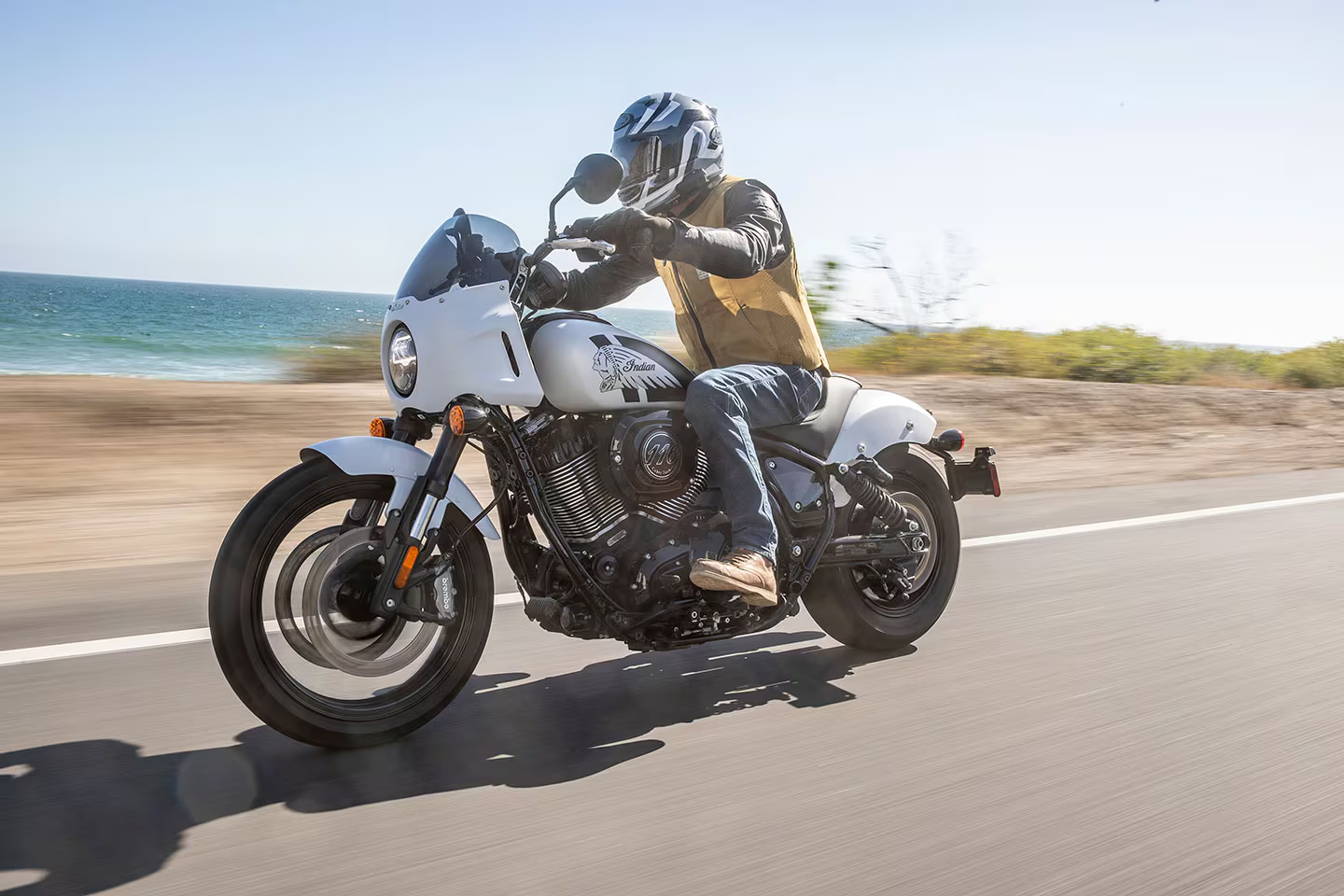
The Low Rider’s higher levels of refinement and “cleaner” tuning show through elsewhere, like in the M-8′s broad power curve. The Sport Chief’s Thunderstroke 116 is your typical heavyweight fighter, with haymaker hits in limited doses; blow through the meaty bottom-end and suddenly the two-valve engine runs out of breathing and power tapers off. The Low Rider S has a touch less grunt at very low rpm but has a healthier midrange, which makes it a more flexible engine. It’s punchy enough for around-town riding, smooth at highway speeds, and has a more free-revving top-end for when you want to pick up the pace. Which you should do—that upgraded suspension isn’t just for looks.
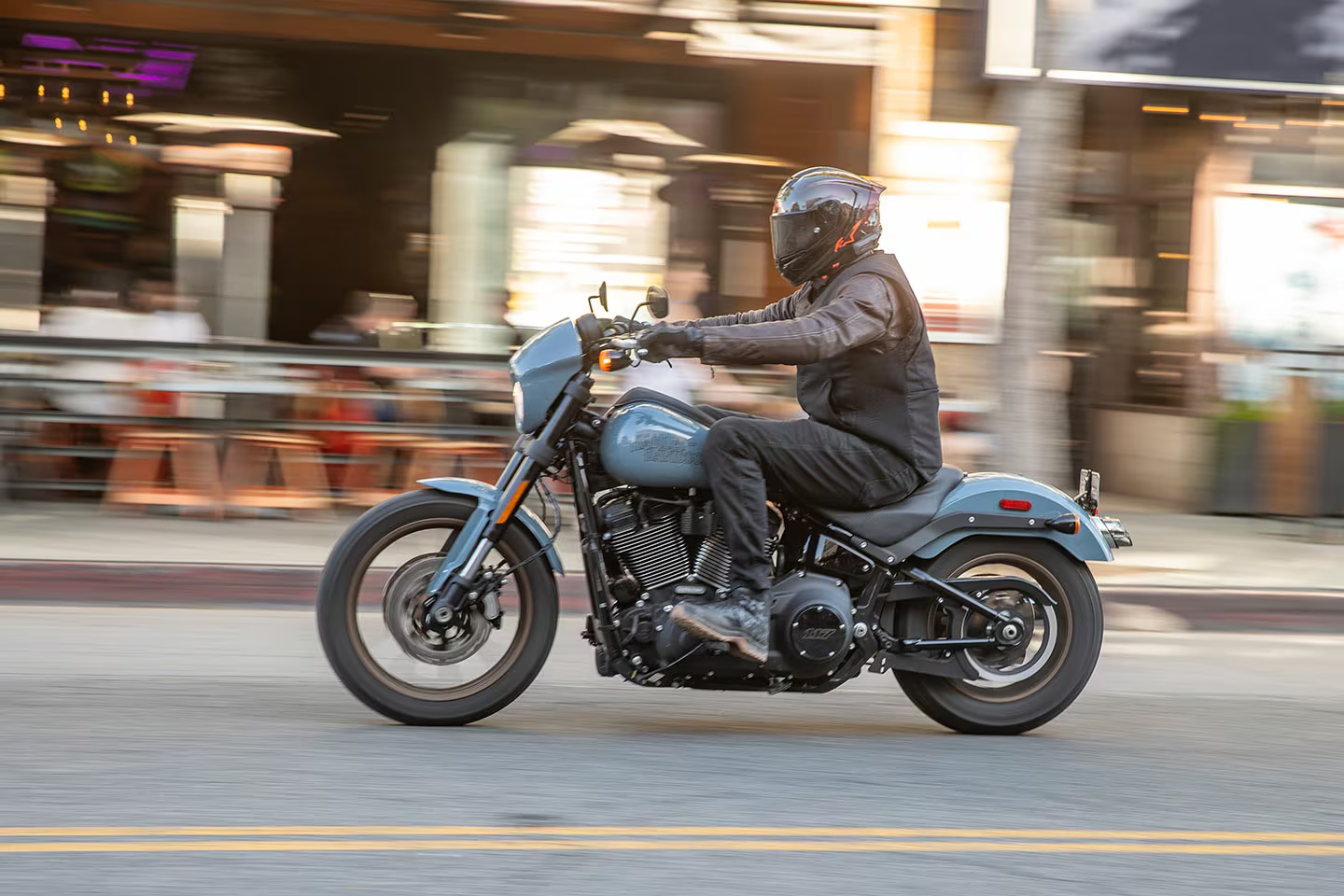
When the Cruising Ends
Our biggest day on these bikes consisted of a cruise on Pacific Coast Highway, followed by lunch at Neptune’s Net (many a Dyna have wheelied by here) and what seemed like a never-ending afternoon tearing through the Santa Monica mountains. We’d be lying if we told you that either has sportbike-like performance. But each bike pushes the limit of what a showroom-stock big-twin cruiser is capable of and they turn out to be wicked fun on smooth sections of flowing canyon road.
The nod goes to the Low Rider S, however, thanks to its slightly lighter weight (678 pounds versus 687 pounds) and increased willingness to go from one side of the tire to the other as you muscle the bikes through nature’s chicanes. The Low Rider S has a narrower front tire (110 versus 130), which influences steering feel and response in this way. An added benefit is that the Low Rider has 1.8 degrees more cornering clearance, which meant less custom footpeg reshaping over the course of our canyon rides. Don’t get us wrong, there’s still a lot of footpeg grinding on both bikes.
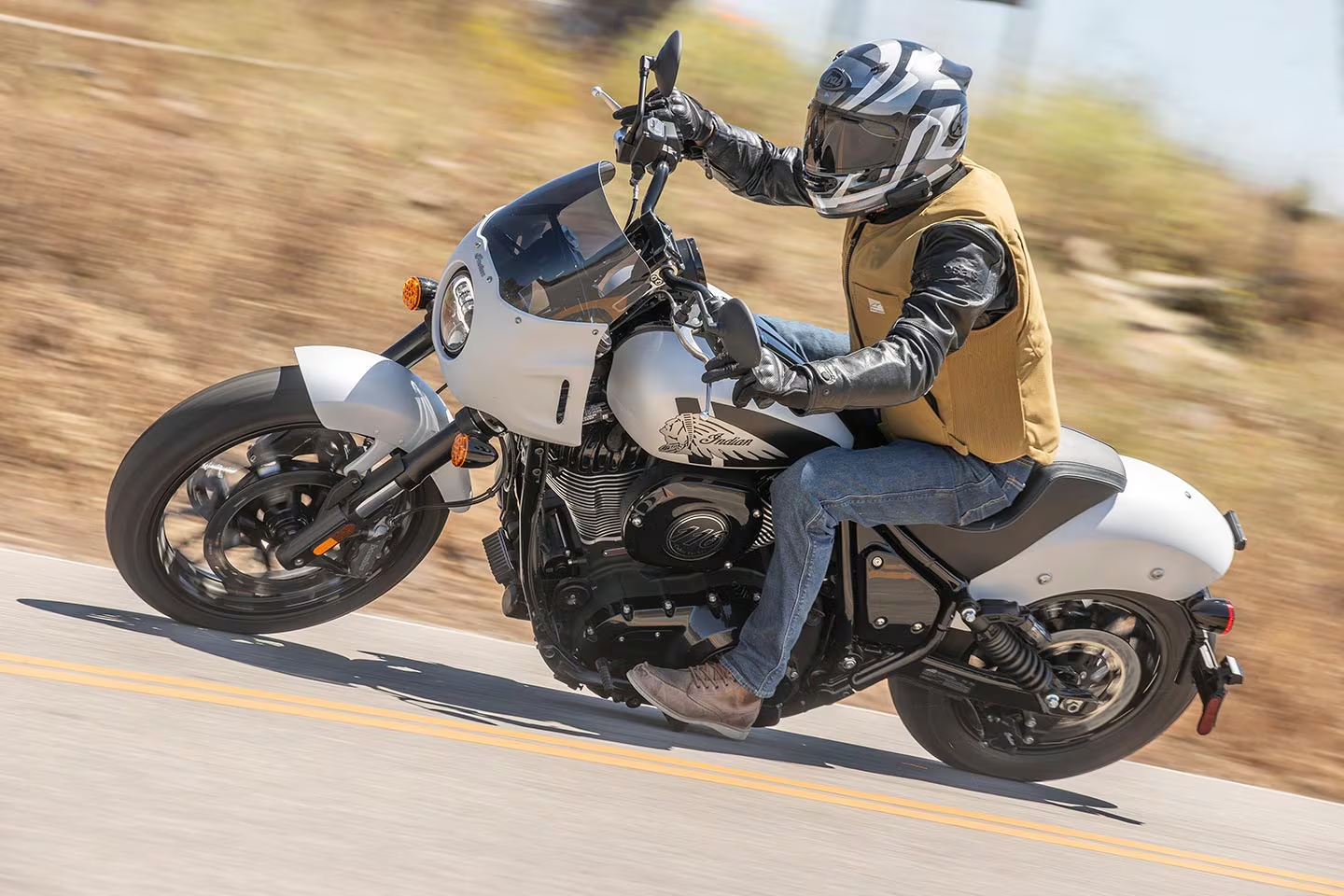
Other performance upgrades on the Sport Chief are a combination of hit and miss. Stiffer suspension sends the occasional shock down your spine on rough roads, but allows you to be more aggressive with your inputs in the canyons. The stiffness makes the ride experience more dynamic and engaging, even if a little exhausting over time. Everything you do on the Sport Chief is etched in your memory because of the sounds and vibrations and aggressiveness to it. The Low Rider just sort of exists in your memory of the ride, because of its smoothness and the way it quietly goes about its business.
Another example is the brakes. Theoretically, the Sport Chief’s radially mounted Brembo calipers should offer massively improved stopping power over the Low Rider’s lower-spec setup. Imagine our surprise then when we preferred the Low Rider’s braking package for the more fluid stopping power and increased feel at the lever. Sometimes things can be less than the sum of their parts.
There are still wins though: The Sport Chief is more comfortable for a wider range of riders. Both bikes have mid-controls, but the Harley’s pegs are higher and create more of a bend in a taller rider’s knees—cornering clearance isn’t free. Indian’s tall-back seat has a more supportive foam and is all-day comfortable, whereas the Harley’s seat foam is so soft that you start to feel pressure points after an hour or two in the saddle. One of our test riders did identical six-hour rides over the course of a weekend and couldn’t wait for the ride to be done on the Harley due to that soft seat causing pressure points in areas where you don’t want pressure points. Those same six hours flew by on the Indian. How many Low Riders will stay stock for very long? Added comfort is just an aftermarket seat away, even if that incurs an additional cost that is not required on the Sport Chief.
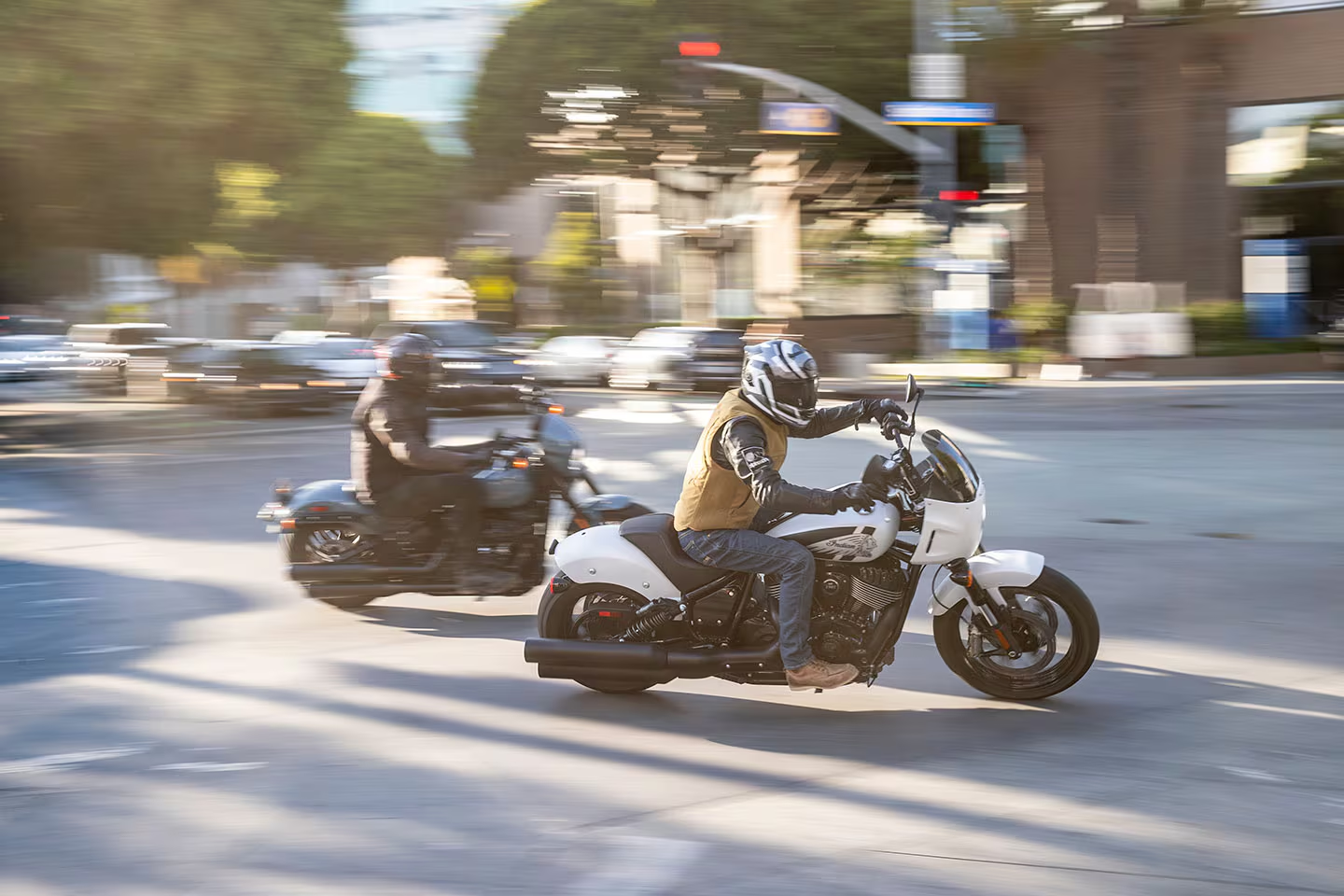
Final Thoughts
Speaking of the aftermarket (and cruiser scene as a whole), we couldn’t think of a better place to end our test than at one of the most iconic custom and vintage motorcycle events in the States: the Born-Free Show. Bikes like these exist because of the culture that was built around shows like this, and shows like this exist because of the culture built around bikes like these.
Not surprisingly, considering Harley has been building and customizing bikes for a steadier period of time, not to mention working tirelessly to build a culture around its brand, there are more Bar & Shield bikes than anything else. Will the Sport Chief help Indian take a bigger piece of that pie, and more importantly, is it a better motorcycle than the Low Rider S? The short answer is no.
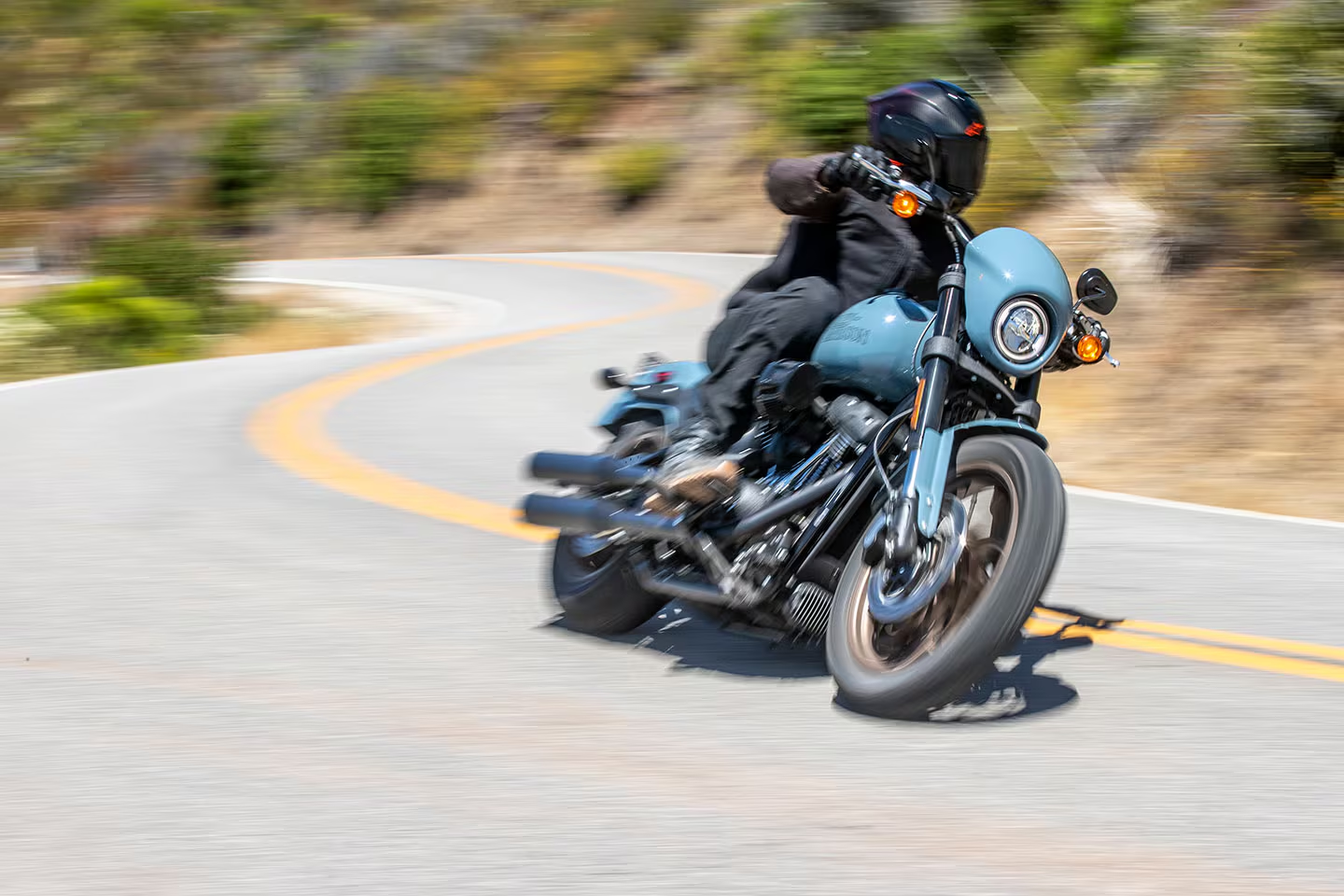
The long answer is more complicated, because in some ways the Sport Chief is a better take on the West Coast–style performance cruiser. We appreciate the Indian’s more polished appearance, its punchy bottom-end, added comfort, and of course the look of those outboard shocks. But while we also enjoy the bike’s rawness, life has taught us that lust doesn’t hold a candle to love in the long run.
That is not to say you will immediately love the Low Rider S, but that the package is fewer tweaks away from being a really entertaining, capable, and comfortable bike that’s just as fun cruising up the coast as it is hustling down a canyon road. It handles better, the engine has better overall performance, and unlike the Indian, our testbike never suffered from small quirks like a slow-starting display. It is, quite simply, the best showroom-stock West Coast–style cruiser.
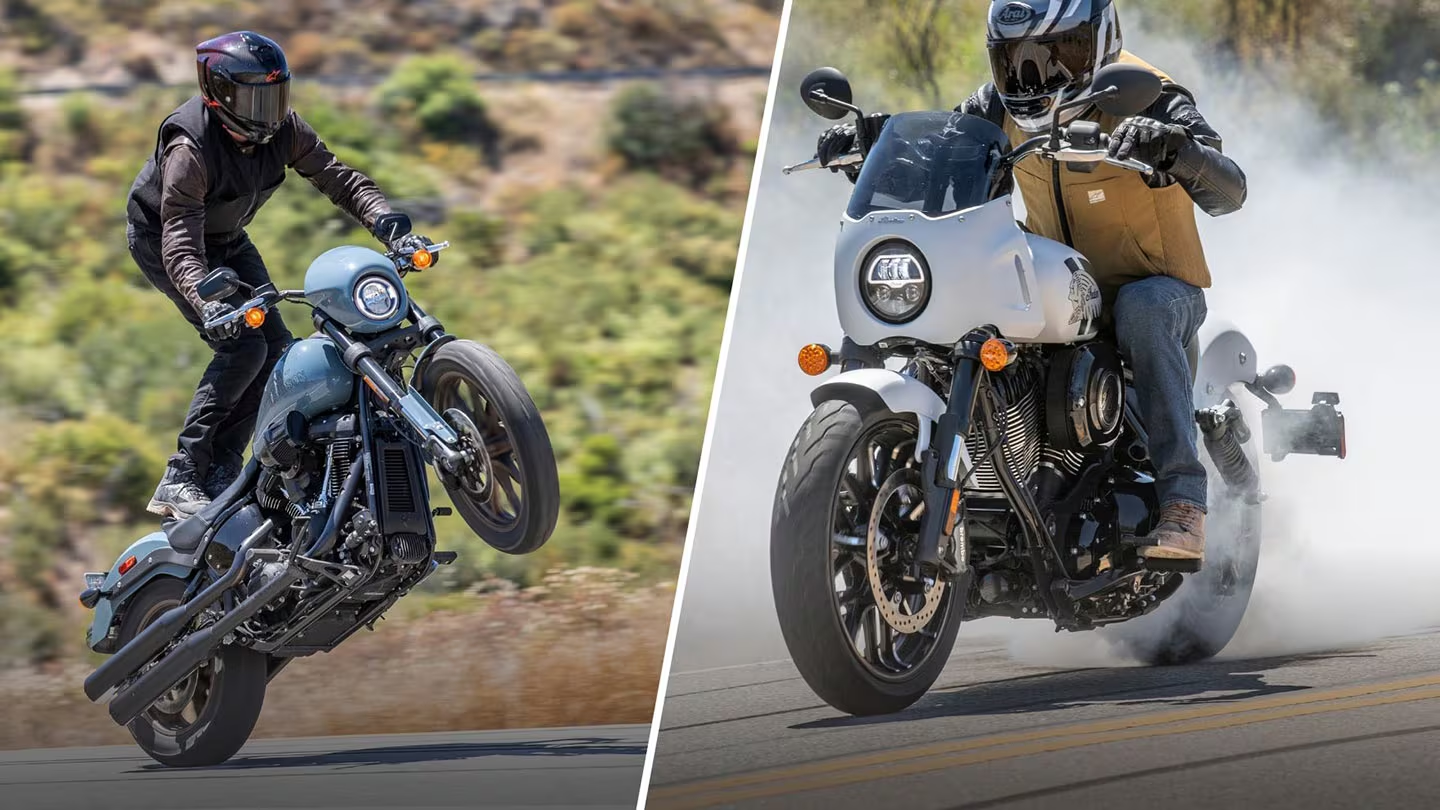

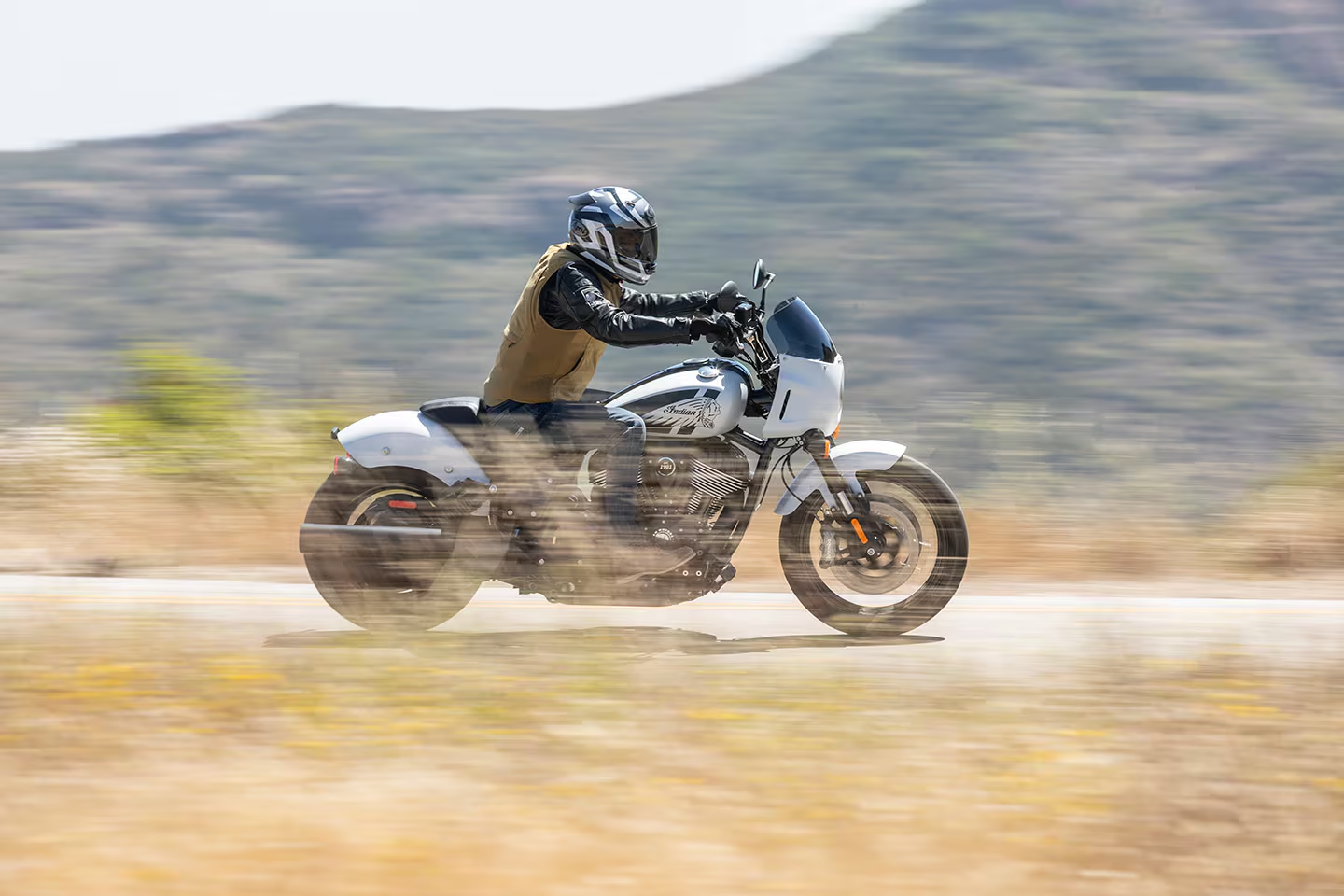

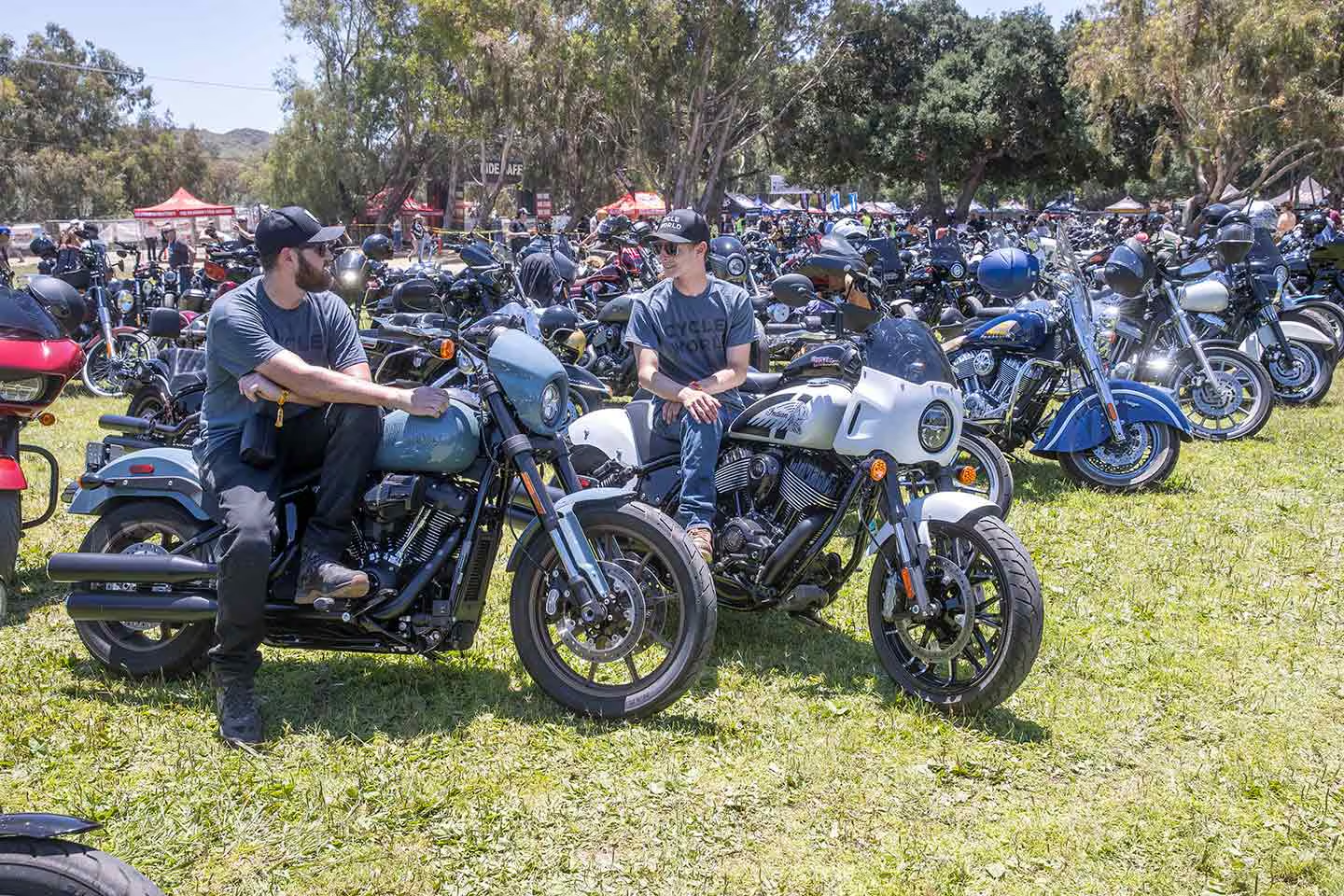
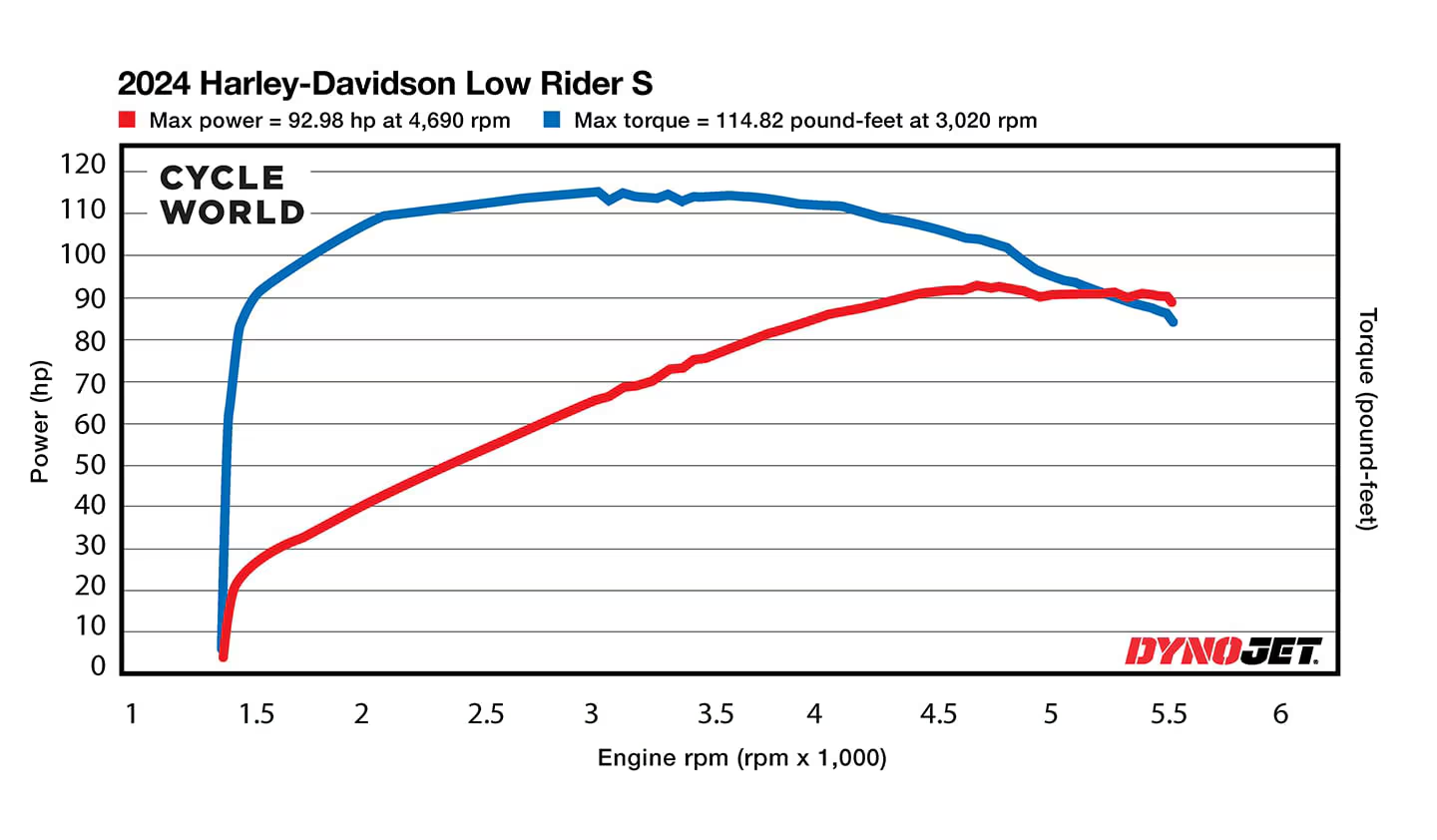
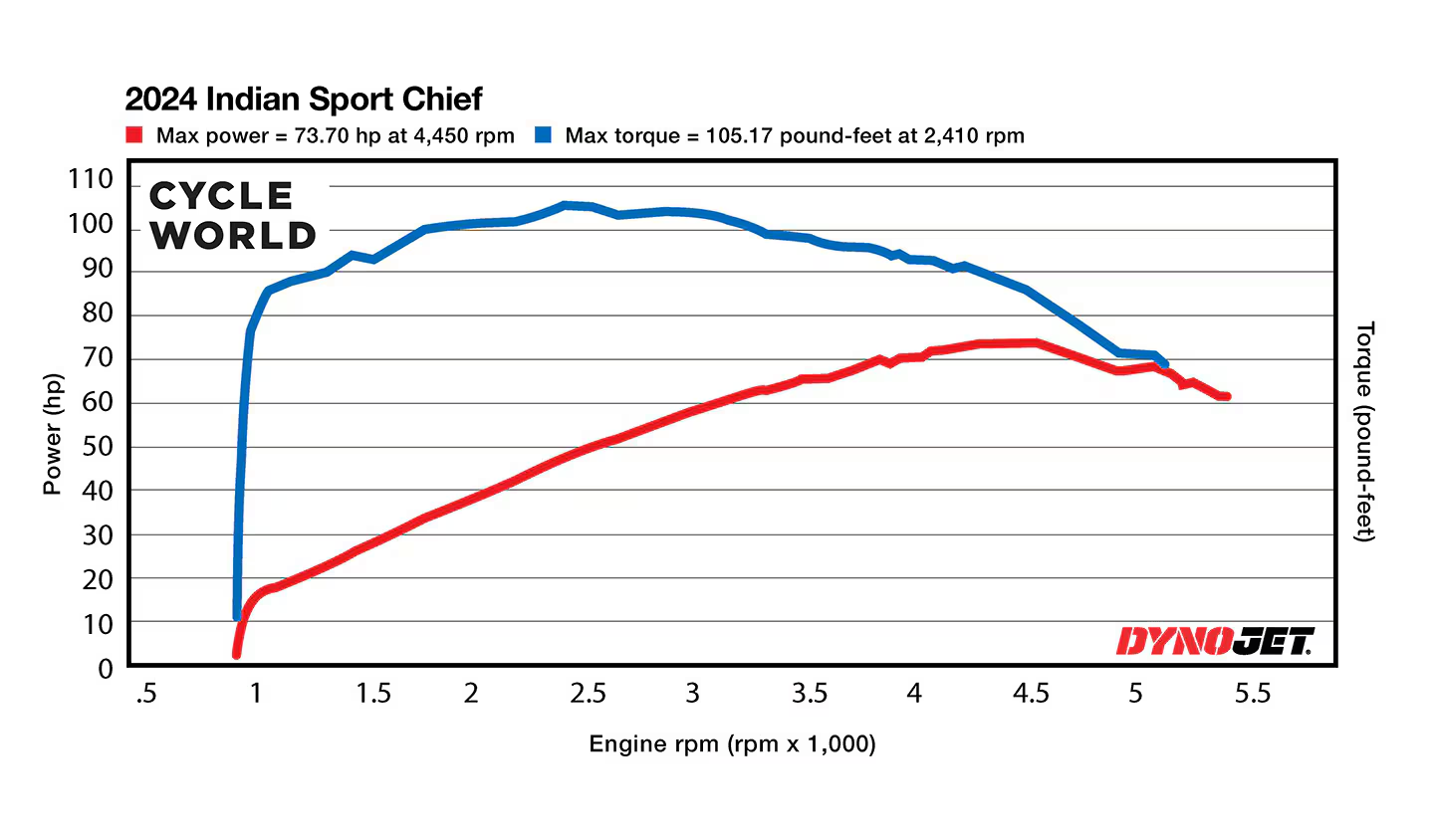
Gearbox:
Helmet: Alpinestars Supertech R10
Jacket: Oscar by Alpinestars Brass Leather Jacket
Vest: Alpinestars Tech-Air 3 Canvas
Pant: Alpinestars Copper V3
Gloves: Alpinestars x Diesel Kei Leather Gloves
Boots: Alpinestars CR-6 Drystar Riding Shoe
Helmet: Arai Contour-X
Jacket: Alpinestars
Vest: Alpinestars Tech-Air 3 Canvas
Pant: Alpinestars Copper V2 Denim
Gloves: Alpinestars Chrome
Boots: Oscar by Alpinestars Monty

2024 Harley-Davidson Low Rider S Specs
| MSRP: | $19,999 ($20,649 as tested) |
|---|---|
| Engine: | Oil/air-cooled Milwaukee-Eight 117 V-twin; 8 valves |
| Displacement: | 117ci (1,917cc) |
| Bore x Stroke: | 103.5 x 114.3mm |
| Compression Ratio: | 10.2:1 |
| Transmission/Final Drive: | 6-speed/belt |
| Cycle World Measured Horsepower: | 93.0 hp @ 4,690 rpm |
| Cycle World Measured Torque: | 114.8 lb.-ft. @ 3,020 rpm |
| Fuel System: | Electronic Sequential Port Fuel Injection |
| Clutch: | Wet, multiplate |
| Frame: | Steel tubular |
| Front Suspension: | 43mm inverted cartridge fork |
| Rear Suspension: | Coilover shock, spring preload adjustable |
| Front Brake: | 4-piston caliper |
| Rear Brake: | 2-piston floating caliper |
| Wheels, Front/Rear: | Radiate cast aluminum; 19 in./16 in. |
| Tires, Front/Rear: | Michelin Scorcher 31; 110/90B-19 / 180/70B-16 |
| Rake/Trail: | 28.0°/5.7 in. |
| Wheelbase: | 63.6 in. |
| Ground Clearance: | 5.7 in. |
| Seat Height: | 28.2 in. |
| Fuel Capacity: | 5.0 gal. |
| Cycle World Measured Wet Weight: | 678 lb. |
| Contact: | harley-davidson.com |
CW Measured Performance
| Quarter-Mile: | 12.34 sec. @ 110.07 mph |
| 0–30 mph: | 1.54 sec. |
| 0–60 mph: | 3.72 sec. |
| 0–100 mph: | 9.52 sec. |
| Braking, 30–0 mph: | 31.68 ft. |
| Braking, 60–0 mph: | 128.75 ft. |
2024 Indian Sport Chief Specs
| MSRP: | $19,999 ($20,499 as tested) |
|---|---|
| Engine: | Air-cooled Thunderstroke 116, 49° V-twin; 4 valves |
| Displacement: | 115.3ci (1,890cc) |
| Bore x Stroke: | 103.2 x 113.0mm |
| Compression Ratio: | 11.0:1 |
| Transmission/Final Drive: | 6-speed/belt |
| Cycle World Measured Horsepower: | 73.7 hp @ 4,450 rpm |
| Cycle World Measured Torque: | 105.2 lb.-ft. @ 2,410 rpm |
| Fuel Delivery: | Closed-loop fuel injection w/ 54mm throttle bodies |
| Clutch: | Wet, multiplate |
| Engine Management: | Ride-by-wire |
| Frame: | Steel tube w/ cast aluminum rear subframe |
| Front Suspension: | 43mm KYB inverted telescopic fork; 5.1 in. travel |
| Rear Suspension: | Dual Fox shocks w/ piggyback reservoirs, spring preload adjustable; 4.0 in. travel |
| Front Brake: | Dual Brembo 4-piston radial-mount calipers, semi-floating dual 320mm discs w/ ABS |
| Rear Brake: | 2-piston caliper, 300mm floating disc w/ ABS |
| Wheels, Front/Rear: | Cast; 19 x 3.5 in. / 16 x 5.0 in. |
| Tires, Front/Rear: | Pirelli Night Dragon; 130/60B-19 / 180/65B-16 |
| Rake/Trail: | 28.0°/4.4 in. |
| Wheelbase: | 64.6 in. |
| Ground Clearance: | 5.9 in. |
| Seat Height: | 27.0 in. |
| Fuel Capacity: | 4.0 gal. |
| Cycle World Measured Wet Weight: | 687 lb. |
| Contact: | indianmotorcycle.com |
CW Measured Performance
| Quarter-Mile: | 13.33 sec. @ 102.64 mph |
| 0–30 mph: | 1.88 sec. |
| 0–60 mph: | 4.55 sec. |
| 0–100 mph: | 12.38 sec. |
| Braking, 30–0 mph: | 37.40 ft. |
| Braking, 60–0 mph: | 148.50 ft. |


